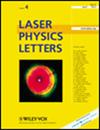纳秒激光直接金属化氮化铝陶瓷
IF 1.4
4区 物理与天体物理
Q3 OPTICS
引用次数: 0
摘要
本文研究了脉冲纳秒激光辐射的激光加工参数对氮化铝陶瓷金属化程度和金属化表面质量的影响。实验旨在利用直接激光金属化技术制造出电阻最小的导电结构。获得并分析了电阻与持续时间、脉冲重叠和激光能量的关系,并考虑了表面粗糙度的变化。此外,还利用能量色散 X 射线光谱研究了激光金属化陶瓷表面的成分。结果表明,电阻与脉冲持续时间的平方根成反比,热扩散长度在 200 ns 时估计为 lT = 8.2 μm,在 4 ns 时估计为 lT = 1.2 μm,并确定了在脉冲持续时间为 200 ns 和 4 ns 时,脉冲重叠 Oy(扫描方向)的最佳值为 50%,脉冲重叠 Ox(阶跃方向)的最佳值分别为 96% 和 99.7%。选择具有最高激光能量的最佳脉冲重叠,使我们能够获得具有最高性能的最小电阻值。本文章由计算机程序翻译,如有差异,请以英文原文为准。
Direct nanosecond laser metallization of AlN ceramics
In this paper, a study of the influence of laser processing parameters with pulsed nanosecond laser radiation on the degree of metallization and the quality of the metallized surface of aluminum nitride ceramics is presented. Experiments were carried out to create conductive structures with the lowest resistance using direct laser metallization. The dependences of resistance on duration, pulse overlap, and laser fluence were obtained and analyzed, and changes in surface roughness were considered. In addition, the composition of the surface of laser-metallized ceramics was studied using energy-dispersive x-ray spectroscopy. As a result, it was shown that the resistance is inversely proportional to the square root of the pulse duration, the thermal diffusion length was estimated as lT
= 8.2 μ m for 200 ns and lT
= 1.2 μ m for 4 ns, and the presence of optimal values of pulse overlap Oy (scanning direction) equal to 50% and pulse overlap Ox (step direction) equal to 96% and 99.7% for pulse durations of 200 and 4 ns, respectively, was determined. The choice of optimal pulse overlaps with the highest laser fluence allowed us to obtain the minimum resistance value with maximum performance.
求助全文
通过发布文献求助,成功后即可免费获取论文全文。
去求助
来源期刊

Laser Physics Letters
物理-仪器仪表
CiteScore
3.30
自引率
11.80%
发文量
174
审稿时长
2.4 months
期刊介绍:
Laser Physics Letters encompasses all aspects of laser physics sciences including, inter alia, spectroscopy, quantum electronics, quantum optics, quantum electrodynamics, nonlinear optics, atom optics, quantum computation, quantum information processing and storage, fiber optics and their applications in chemistry, biology, engineering and medicine.
The full list of subject areas covered is as follows:
-physics of lasers-
fibre optics and fibre lasers-
quantum optics and quantum information science-
ultrafast optics and strong-field physics-
nonlinear optics-
physics of cold trapped atoms-
laser methods in chemistry, biology, medicine and ecology-
laser spectroscopy-
novel laser materials and lasers-
optics of nanomaterials-
interaction of laser radiation with matter-
laser interaction with solids-
photonics
 求助内容:
求助内容: 应助结果提醒方式:
应助结果提醒方式:


